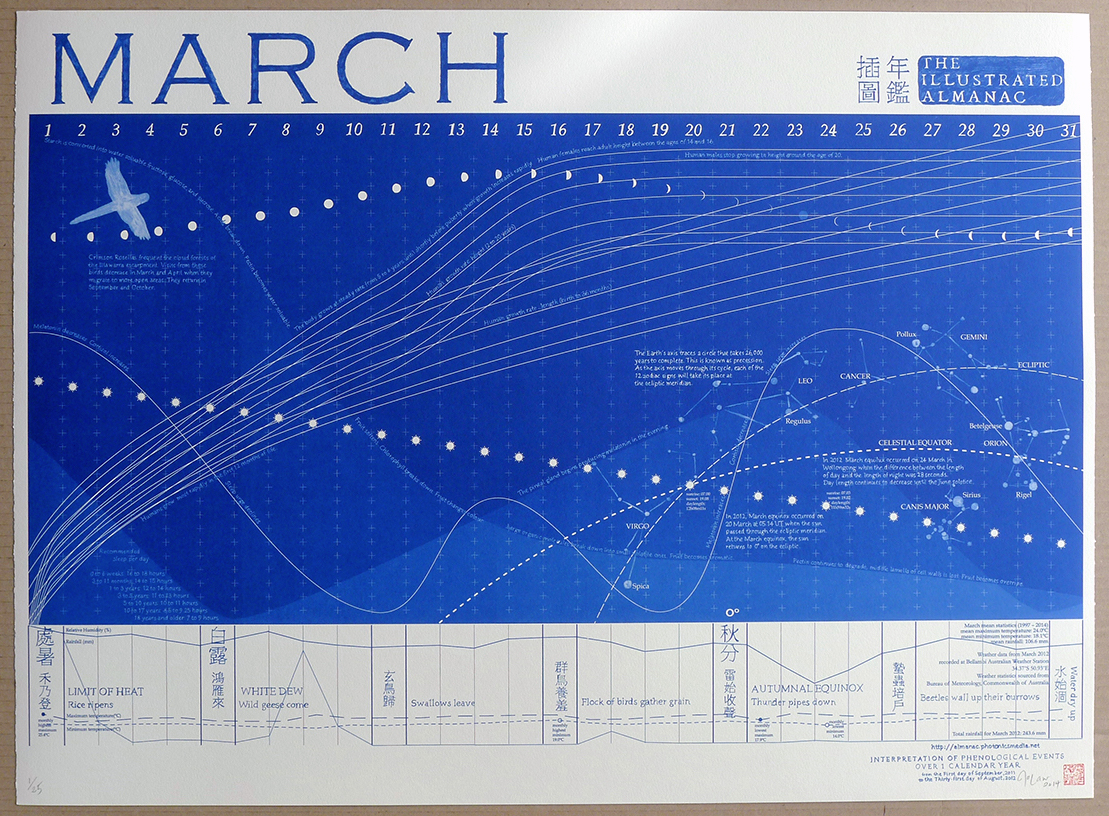
This catalogue essay was commissioned by Jo Law for her exhibition of the Illustrated Almanac of the Illawarra and Beyond, at Wollongong Art Gallery, August 2017. The essay touches on time systems, attention, observances and the Anthropocene.
More on the Almanac prints here
What's the time? It's 9.40am, according to the clock in the menu bar. An innocuous answer, but also a manifestation of something much bigger. Once this marker would have felt provisional or local, close-enough but never-quite-exactly the time; I recall trying as a teenager to set my cheap quartz wristwatch to the AM radio "pips" in a doomed attempt at precision. That temporal imprecision, or rather tolerance, has closed up more recently. My menu bar clock reports network time: a time marker that is constantly resynchronised to a set of authoritative reference points. Network Time Protocol (NTP) is a technical infrastructure that propagates UTC — Coordinated Universal Time — through the internet. It coordinates time sources in layers or strata of "time servers", with atomic reference clocks synchronising a networked hierarchy of ultra-accurate devices. "Time servers": if time is a fixed and stable reference point, if "the time" is an answerable question, then it can be served to us, prompt and efficient. Buried in my computer's file system I find a file called ntp.drift; it records the divergence between the internal clock and the NTP server it queries; a measure of the tolerance in our networked time infrastructure. My menu bar clock is 14.7 millionths of a second fast.
Our culture lives and works in network time, grid time. This is a technical and administrative infrastructure but also increasingly a cultural disposition. A feeling of global "real time" linked to an accelerated, crisis-driven sense of the event. Networked communication and ubiquitous information feed an anxious awareness of global simultaneity, haunted by the nagging fear of what might happen next, what news the next update holds. Hit reload.
While it is probably inescapable, grid time can be resisted. The history of the standardisation of time systems records several hundred years of political struggle over the dominion and control of the grid. In the late 1800s Britain sought to establish Greenwich Mean Time as a reference-point to coordinate its far-flung Empire, but it met with significant resistance in India, where cities like Bombay and Kolkata maintained their own standards. Our Gregorian calendar — the oddly irrational day-grid that contains the clock-grid — was taken up widely around the turn of the twentieth century against the opposition of the Christian Orthodox church. Iran and Afghanistan continue to run on the 2000-year-old Persian calendar, whose year is based on the vernal equinox. In China, the revolutionary Republic adopted the Gregorian calendar in 1912, but the country continues to maintain two parallel calendars; the traditional lunisolar calendar meshes with the globalised Gregorian. We shouldn't take "Coordinated Universal Time" at face value. Other times and rhythms persist, even inside the grid.
One of the hallmarks of grid time is its indifference, not just to other time systems, but to what happens in time. Religious calendars are marked by rituals, feasts and observances: meaningful happenings. The Persian calendar hinges on a celestial reference point. Time is shaped by activity, much as space (Einstein shows us) is actually bent by the matter within it. Grid time, by comparison, stretches on implacably, 24/7/365.

In the Illustrated Almanac Jo Law draws us into a plurality of times that teem with happenings. Gregorian grid time is overlayed with the Chinese lunisolar calendar, which is in turn relocalised for our upside-down southern seasons. Law shows us the 24 solar terms within the Chinese calendar, which mark the solstices and equinoxes, as well as seasonal temperature shifts. Within each term are three pentads, and here the calendar springs to life: mantids hatch, cicadas sing, garlic chives sprout, beetles wall up their burrows. Agriculture, weather, cosmic energy and what we (in the Anthropocene) call "wildlife" all commingle. Rice ripens, tiger prowls, rainbows hide, little frogs peep.
We retain observances in our calendar: Good Friday, Anzac Day, Melbourne Cup. To observe them is to give them our attention and thus our respect. In the Illustrated Almanac observances multiply; we encounter a calendar that marks and respects a lively world, a temporal tangle of humans, nonhumans, planets and substances. Rather than instituting rituals, it primes our attention; instead of calling us indoors to church, it sends us out into the fields, to watch the weather or the passing birds.
The Almanac shows us phenological time: the pacing and rhythms of growth, migration, breeding and hibernation in the nonhuman world. This makes for an easy counterpoint with the blank, rigid precision of grid-time, but as Law's work shows it's not that simple. Pining for some (imaginary) pre-modern state of grace won't get us far: the Anthropocene is a time of tangles that can't be unwound; humans and nonhumans, the living and the dead, matter, energy and capital. But phenological time can tune us in to the tangles, draw our attention to their shifting rhythms. Phenology is emerging as an important source of climate change data. Yasuyuki Aono at Osaka Prefecture University has assembled 1200 years of human observations tracking the first flowering of Kyoto's cherry trees; warming since the Industrial Revolution has seen the blossoms appear some five days earlier in the year, on average. In the northeastern US a population of cicadas grow and hatch on a 17-year cycle; in May 2017 one group (Brood X) began emerging from their burrows three years early. Here phenological time warps, as the world warms; by recording and reading these variations against the grid of solar time, these long-term patterns become legible.
Similarly, Law's Almanac lets us read these times against each other; it also models a practice of attention, observation and record-keeping that weaves living, phenological time into the blank squares of the grid and the network. The network is an "attention economy"; a jostling frenzy of clickbait and ad impressions, an endless fountain of distraction. It can easily pull us away from the living matrix that still (for now) sustains us; but it need not. Technologies of data-gathering and record-keeping have neer been cheaper or more ubiquitous; they can help attune us to our tangled state. With the Almanac Law reminds us that where we pay observance — our respectful attention — is up to us.